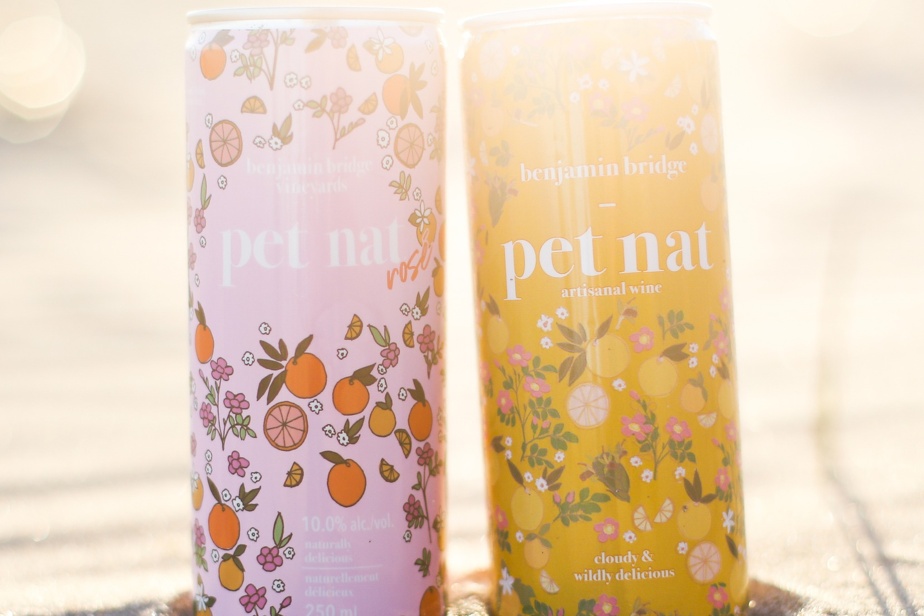After beer and cider, it’s time for wine to be enjoyed in a can. Easy to transport and lightweight, this format is ideal for taking wine outdoors. Here is our selection for the summer.
Nova Scotia’s most prestigious vineyard, Domaine Benjamin Bridge, created a surprise in 2016 by marketing its first wine in a can. Known for its artisan sparkling wines sold after long ageing, the vineyard wanted to offer a more ecological option to its consumers.
“The single-use glass is one of the major problems and discomforts of wine,” says Benjamin Bridge’s chief winemaker, Jean-Benoit Deslauriers. Empty bottles travel from Asia or Europe to be filled once, then they are buried. »
Unlike the glass bottle, the aluminum can can be recycled endlessly. In addition, it emits three times less carbon dioxide per liter than the classic container.
Consume quickly
However, if the can is an ecological choice, it is not a coincidence that Benjamin Bridge chose this container for its cuvées of fast consumption and those without added sulphites. According to Jean-Benoit Deslauriers, the protective film located inside can degrade and make the wine less good over time.
Benoît Marsan, professor in the chemistry department of the University of Quebec in Montreal and specialist in wine science, confirms this observation. “The high acidity of the wine and the added sulphites promote corrosion,” he explains. It deteriorates the polymer membrane and the wine comes into contact with the aluminum. This phenomenon causes reduction, a gas with the smell of rotten eggs. Thus, the professor recommends consuming the can in the months following its production.
However, this rule is difficult for the consumer to follow, since “canned wine does not have to bear an expiry date”, confirms the Société des alcools du Québec (SAQ).
High increase
However, the enthusiasm for this format is far from over. In Quebec, sales in dollars have grown by 43% over the past year, despite a meager offer of around twenty products at the SAQ.
According to a report published by the firm Straits Research, the global canned wine market is expected to reach US 725.48 million by 2030, with an average annual growth rate of 13%.
Our Suggestions
Rosé from here

PHOTO FROM THE SAQ WEBSITE
Domain of Lavoie 2020
In Rougemont, the Domaine de Lavoie was the first vineyard in Quebec to put its rosé in a can. From the 2020 vintage, the rosé is colorful and very good. The blend of Sainte-Croix, Chaunac and Maréchal Foch hybrid varieties smells of raspberries and orange zest. We perceive in the mouth a sweet touch that brings length. With sushi and friends, the agreement will be successful.
Domaine de Lavoie 2020, $4.55 (14646970), 12%
Local picket

PHOTO FROM THE DOMAINE DU NIVAL WEBSITE
Vidal brandy 2022
Several Quebec producers are marketing sticks in cans this summer in specialized grocery stores. This low-alcohol drink is produced by fermenting the sugars contained in grape pomace with water. The Domaine du Nival is part of the lot. Its “eau-de-vin de Vidal 2022” label is produced in contact with the marc of the Vidal grape variety. The producer added a little apple juice to increase the complexity of the beverage and its alcohol content. The 473 ml can is larger than the usual size chosen for wine. Perfect for big thirsts!
Vidal 2022 eau-de-vin, $32 for 4 x 473ml, 3.8%
The Benjamin Bridge piquette soon at the SAQ

PHOTO FROM BENJAMIN BRIDGE’S WEBSITE
Benjamin Bridge Piquette Original
A picket from the Benjamin Bridge estate will soon arrive at the SAQ. The “original” cuvée is prepared with the marc of several aromatic white grape varieties, including Sauvignon, Muscat, Musk Chardonnay, Ortega and Geisenheim. Everything is flavored with a hint of local salt from the Bay of Fundy and Citra hops. It will appeal to both wine and beer lovers.
Benjamin Bridge Piquette Original, $25 for 4 x 250ml (15149191), 4%
A touch of red

PHOTO FROM THE SAQ WEBSITE
Klee Pinot Noir Willamette Valley
According to chemistry professor Benoît Marsan, red is the color of choice for canned wine because it is generally less acidic. This American Pinot Noir proves it. Produced in Oregon by winemaker Chris Berg, it exudes dark cherry and earthy flavors typical of the varietal. On the palate, the supple and juicy attack is full of sunshine. The subtle smoky notes evoke both the volcanic terroir and the aging in oak barrels. Another asset, the winemaker is known for his minimal use of sulphites. The can will be a hit with a hearty BLT sandwich or a warm grilled beef salad. Especially since it is more economical to buy three than a 750 ml bottle.
Klee Pinot Noir Willamette Valley, $9.30 (14794278), 13.5%
